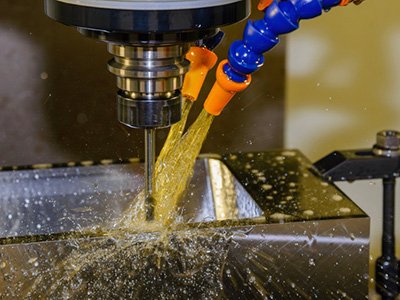Avoiding Chemical Contamination During Part Cleaning and Washing

Cleaning precision components involves much more than simply washing parts after production. At Protomatic, we understand that effective cleaning begins with controlling the manufacturing processes themselves.
Many parts—particularly those used in medical, aerospace, and other high-performance industries—are highly sensitive to specific chemicals. Exposure, even in trace amounts, can compromise part integrity or functionality. With decades of experience supporting critical applications, we’ve developed manufacturing systems that proactively prevent exposure to harmful substances.This is over and above typical manufacturing, but is critical to the success of the product.
Compliance Is the starting point—Not the finish line
Most manufacturers are familiar with chemical compliance standards such as REACH, RhoS, WEEE, and California Prop 65. These regulations focus on known hazardous chemicals found in product materials or manufacturing processes. However, our approach at Protomatic goes a step further—beyond regulatory compliance—to address additional concerns specific to product performance.
Industries with heightened sensitivity to chemical exposure
Protomatic specializes in CNC machining for industries with particularly sensitive part-cleaning requirements, including:
- Specialized Assembly
- Medical
- Aerospace
We also have extensive experience supporting satellite systems, vacuum-based parts for integrated circuits, and R&D platforms such as particle accelerators. In these applications, even minor contamination from residual elements or compounds can lead to functional failure. That’s why we have stringent processes in place to eliminate chemical exposure risks.
Chemical avoidance as a process control strategy
As an initial step in our advanced control planning, we begin by developing a comprehensive list of potential chemical exposures. This list is reviewed and tailored during the quoting phase, ensuring that sensitive materials are either avoided or eliminated before production begins.
The best method of controlling contamination is complete avoidance. For many advanced applications, this level of care is not just beneficial—it’s mission-critical.
Below is a summary of chemical compounds that are commonly present in general manufacturing but must be avoided or tightly controlled in sensitive environments:
Possible chemical exposure and concerns by industry
INDUSTRY: High vacuum
- EXPOSURE: Coolants
- CONCERN: Halides
- EXPOSURE: Deburr and sanding
- CONCERN : Aluminum oxide vs silicone carbide
- EXPOSURE: Cutting tools
- CONCERN: High speed vs carbide
- EXPOSURE: Holding fixtures
- CONCERN: Steel vs non-steel
INDUSTRY: Medical
- EXPOSURE: Polishing compounds
- CONCERN: Animal vs synthetic lubricants
INDUSTRY: All, adhesive bond
- EXPOSURE: Coolants
- CONCERN: Oil
INDUSTRY: All
- EXPOSURE: Detergent (soap)
- CONCERN: Chemical and method
- EXPOSURE: Degreasing
- CONCERN: Chemical and method
- EXPOSURE: Finishes
- CONCERN: As specified
Types of Cleaning
There are many types of part cleaning, but the most common methods involve mechanical or ultrasonic agitation using etching or degreasing solutions followed by rinsing. Once cleaned, parts are verified using methods such as:
- Wipe Test
- Water Break Test
- Particle Count Test
In many industries, finishing processes also serve as part-cleaning steps. This is widely accepted, especially when finishing operations include etching. Common examples include:
- Passivation
- Anodizing
These may occur before or after inspections like:
- FPI (Fluorescent Penetrant Inspection)
- MPI (Magnetic Particle Inspection)
Alloy-Specific Cleaning
Stainless Steel – Passivation
Passivation is a surface etching process that removes free iron from stainless steel, helping prevent corrosion and surface rust. This process is designed not to alter dimensional tolerances, though it may leave a slightly dull finish or evaporation marks. Common specifications include:
- QQ-P-35 (legacy)
- ASTM A967
- ASTM F86
- AMS 2700
Chemistries typically involve nitric or citric acid.
Aluminum – Anodizing
While basic cleaning is possible, the most effective process is a controlled etching and corrosion method that enhances corrosion resistance.
Common finishes:
- Sulfuric Acid Anodizing (ASTM A8625)
- Type II: Standard Anodize
- Type III: Hardcoat Anodize
- Chemical Film Coating (MIL-DTL-5541)
Often referred to by trade names like Chem Film, Alodine, or Iridite
Our Part is Saving Lives
Protomatic is a CNC precision machining shop specializing in prototype and short-run production components for the medical, aerospace, and other technical industries. Meticulous attention to detail is part of our commitment to Life-Saving Precision in every part and device we make. If you have any questions or require application-specific guidance, our team is always ready to assist.
Contact Us Directly
📞 734-426-3655
- Geoff Harrigan, Sales Specialist- Geoff@protomatic.com
- Lori Franz, Sales – Lori@Protomatic.com
- Scott Allen, Sales Manager – Scott@Protomatic.com
- Doug Wetzel, VP/GM – Doug@Protomatic.com
- Kyle Helm, Program Manager – Kyle@Protomatic.com

About the Author: Doug Wetzel is Vice President and General Manager of Protomatic


